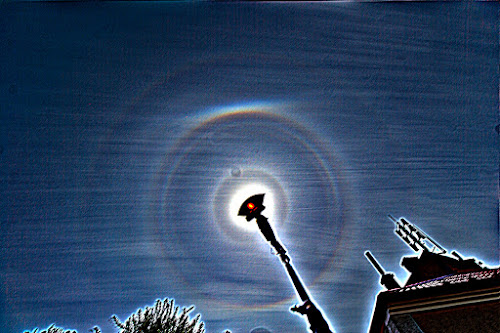On August 26 2020, Zhang Yibing from Pu'er, Yunnan captured a sunset odd-radius display, in which a bright 28° arc dominates the show.
 |
| Stacked and sharpened. © ZHANG Yibing, shown with permission. |
The arc’s brightness is almost on par with the 20° plate arc, while other plate arcs such as the 24° and 35° ones are exceptionally weak and barely show up in stacked photos. What’s more interesting about the 28° arc is its shape. What we are seeing in this display is a gently sun-vex arc which doesn’t quite follow the 28° sun-centric circle.
 |
| Stacked and background subtracted photos reveal a left 28° sun-vex arc as well. Note how both arcs curve away from, instead of follow, the 28° circle. |
Such appearance contradicts current theories. In the 30-32 pyramid and cubic ice models ( http://www.thehalovault.blogspot.com/2018/09/28-plate-arc-captured-in-haikou-china.html ), the predicted 28° arcs do not appear sun-vex like the 24° plate arcs do. Quite the opposite, when the crystals are wobbly, the arcs should look more sun-cave and follow the 28° sun-centric ring.
The puzzling shape can still be achieved by tweaking the available theories though. JI Yun and I did some experiments in ZHANG Jiajie’s simulation program and came up with a bizarre solution.
First is to tilt a triangular 30-32 upper pyramid by 109.5° until one of its pyramidal faces goes horizontal. Then, apply a loose ( 15° wobble or more) sun-ward azimuthal lock on both tilted 30-32 crystal and cubic ice.
The revised models produce identical sun-vex 28° arcs which closely match the ones seen in the display.
The idea of az-locking crystals in the air is certainly outlandish and should hardly be taken seriously unless concrete evidence is found in real world. That being said, there’s only so much we can do with available theories. New ideas/experiments are much needed.
This display marks the 11th record of 28° arcs in China since 2016, and more importantly, the 1st record revealing the arcs' real shape. Is it possible that what we're seeing in this display are actually new halos, different from the previous 10 Chinese records and the legendary Lascar arcs? Or is it that all these Chinese 28° arcs are a same new breed different from the Lascar ones? We'll need many more similar displays to draw a conclusion. Looking forward to the next summer.
Update:
Nicolas Lefaudeux proposed another possibility for the arc's peculiar appearance:
"On my side, the sunvex shape is still not so obvious to me. I see more a vertical elongation of the 28° arc + some patch of 28° halo.
Effects like diffraction by "vertically narrow" crystal faces would create such vertical elongation (like a plate crystal with exotic faces instead of regular prism faces). Unfortunately, such effects cannot be simulated with our current softwares. The appearance of the halos (smooth and rather undefined) make me think of diffraction-affected halos (small crystal faces), like most of the odd radius halos. We would need cases with sharper arcs in order to be more conclusive."













